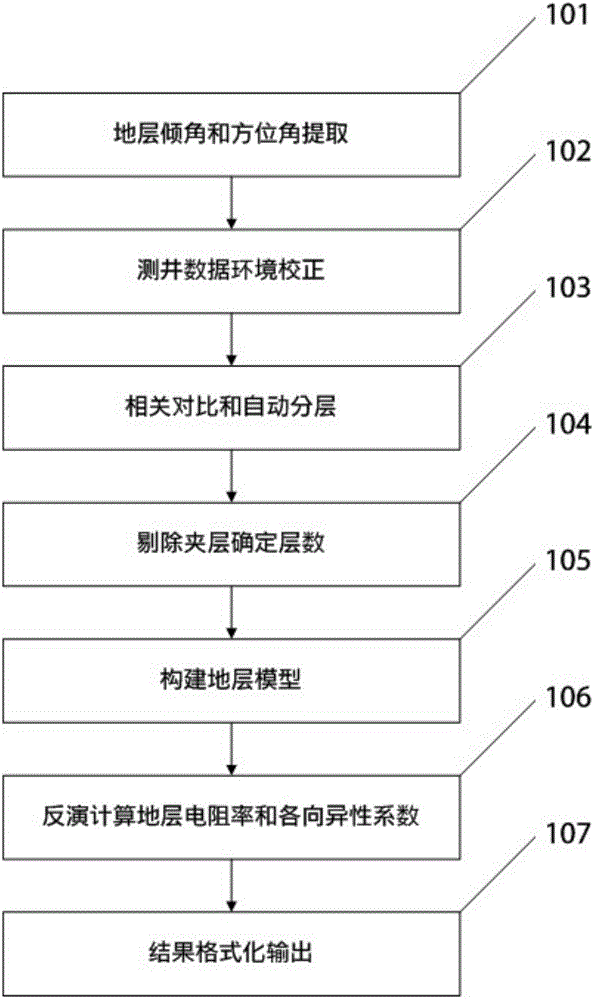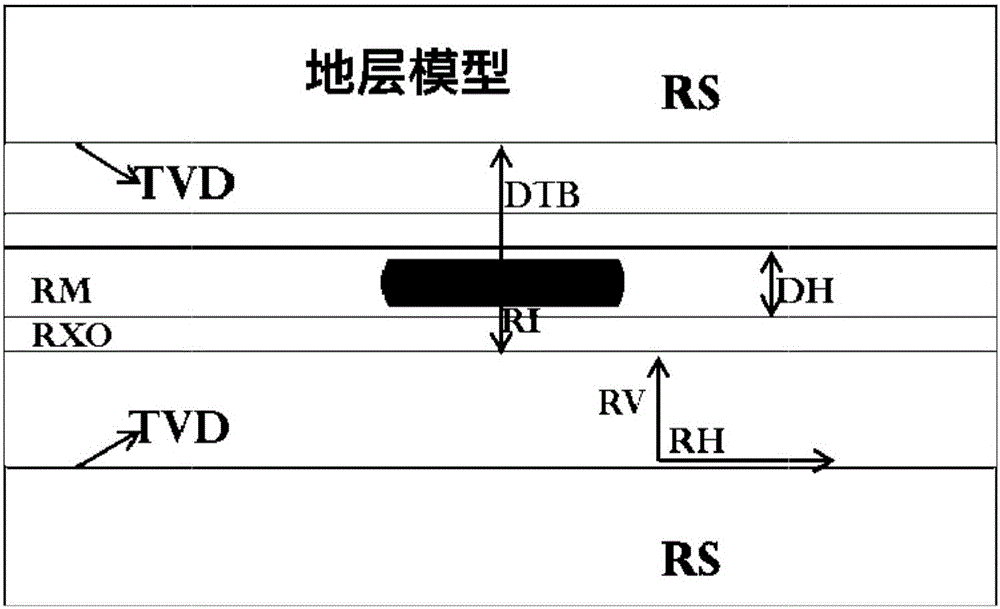Resistivity anisotropy recognition method in horizontal well stratum environment
A technology of anisotropy and identification method, which is applied in the field of resistivity anisotropy identification in the formation environment of horizontal wells, and can solve problems such as the inability to provide layer boundary distance and anisotropy.
- Summary
- Abstract
- Description
- Claims
- Application Information
AI Technical Summary
Problems solved by technology
Method used
Image
Examples
Embodiment 1
[0104] The method for identifying resistivity anisotropy in a horizontal well formation environment provided in this embodiment includes the following steps:
[0105] Step 1. Obtain the azimuth natural GR and azimuth resistivity logging response values according to the horizontal well logging, and use the elevation difference and curve fitting to extract the logging instrument-the formation relative inclination angle and the formation azimuth angle;
[0106] Step 2, performing azimuth correction on the azimuth resistivity logging and azimuthal resistivity logging data according to the dip angle and azimuth angle obtained in step 1;
[0107] Step 3. For the standardized data after azimuth correction, the curve activity is obtained by the correlation comparison method, and the formation interface is divided by the activity method. When dividing the formation interface, the natural GR curve, the azimuth resistivity logging curve, and the azimuth resistivity curves, neutron dens...
Embodiment 2
[0159] This embodiment provides a method for identifying formation anisotropy using azimuthal resistivity logging in complex borehole environments such as horizontal wells and highly deviated wells; it is realized through the following steps:
[0160] Step 1 uses the elevation difference of well logging curves and nonlinear fitting method to extract formation dip and azimuth, including the following steps:
[0161] 1) Use the four azimuth natural GR curves measured by the ABG logging tool to extract the dip angle, and perform a correlation analysis on the four GR curves to obtain the elevation difference of the corresponding layer, which is the six points on the inclined layer of the formation. Since the expansion diagram of the intersection of the borehole wall and the inclined layer appears as a single-period sine function on the image, it satisfies the equation:
[0162] y=Asin(ωx-β)+y 0 (1)
[0163] 2) Non-linear fitting, solve the undetermined coefficient in equation (...
Embodiment 3
[0190] as the picture shows, figure 1 It is a flow chart of a specific embodiment of the method for identifying resistivity anisotropy in the horizontal well formation environment of the present invention; figure 2 It is a schematic diagram of horizontal well formation modeling of the present invention, in which TVD represents the layer boundary position, RM represents the mud resistivity, RI represents the invasion depth, RXO represents the invasion zone resistivity, RS represents the surrounding rock resistivity, and Rh-Rv represents the target level Resistivity - vertical resistivity, DH means borehole diameter; image 3 The horizontal downhole apparent resistivity of the present invention changes with the formation anisotropy coefficient; Figure 4 The phase difference resistivity and amplitude ratio resistivity difference of the apparent resistivity of the present invention vary with the anisotropy coefficient; Figure 5 In the anisotropic formation of the present inve...
PUM
 Login to View More
Login to View More Abstract
Description
Claims
Application Information
 Login to View More
Login to View More - R&D
- Intellectual Property
- Life Sciences
- Materials
- Tech Scout
- Unparalleled Data Quality
- Higher Quality Content
- 60% Fewer Hallucinations
Browse by: Latest US Patents, China's latest patents, Technical Efficacy Thesaurus, Application Domain, Technology Topic, Popular Technical Reports.
© 2025 PatSnap. All rights reserved.Legal|Privacy policy|Modern Slavery Act Transparency Statement|Sitemap|About US| Contact US: help@patsnap.com



